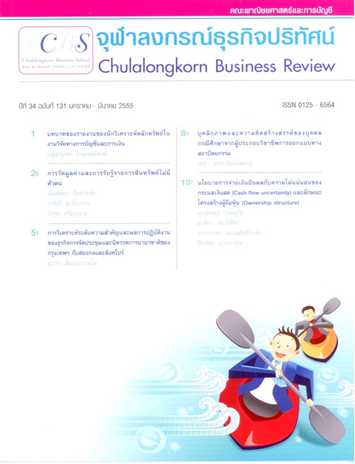บุคลิกภาพและความคิดสร้างสรรค์ของบุคคล กรณีศึกษาจาก ผู้ประกอบวิชาชีพการออกแบบทางสถาปัตยกรรม
Main Article Content
Abstract
บทดคัดย่อ
งานวิจัยนี้มีวัตถุประสงค์เพื่อศึกษาความสัมพันธ์ระหว่างบุคลิกภาพและความคิดสร้างสรรค์ของบุคคล และวิเคราะห์ว่าบุคลิกภาพลักษณะใดมีแนวโน้มที่จะส่งเสริมความคิดสร้างสรรค์ เนื่องจากบุคลิกภาพของบุคคลเป็นคุณลักษณะที่เรียนรู้ ฝึกฝนและพัฒนาได้ และเป็นคุณลักษณะร่วมสมัยตามสภาวการณ์ในปัจจุบัน โดยศึกษาจากกลุ่มตัวอย่างของผู้ที่ประกอบวิชาชีพการออกแบบทางสถาปัตยกรรมแขนงต่างๆ จำนวน 260 คน และใช้แบบทดสอบ Myers Briggs Personality Type Indicator (MBTI) เป็นเครื่องมือประเมินบุคลิกภาพ ผลการศึกษาพบว่า ระดับความคิดสร้างสรรค์มีความสัมพันธ์กับบุคลิกภาพ MBTI Personality Type โดยเฉพาะอย่างยิ่งบุคลิกภาพในด้านการรับรู้ที่ใช้การคาดการณ์อนาคตหรือจากประสบการณ์ในอดีตมาเชื่อมโยง (Intuition: N) และด้านพฤติกรรมที่ยืดหยุ่น สามารถปรับเปลี่ยนไปตามสถานการณ์ เปิดกว้างรับรู้ข้อมูล (Perceiving: P) อย่างมีนัยสำคัญทางสถิติ นอกจากนี้ ยังพบว่าลักษณะบุคลิกภาพ MBTI ที่มีค่าเฉลี่ยระดับความคิดสร้างสรรค์สูงสุด 4 ลำดับแรก ได้แก่ ENTP INTP ENFP และ INFP ที่มีลักษณะบุคลิกภาพร่วมคือ Intuition: N และ Perceiving: P ผลการวิจัยแสดงให้เห็นว่าการพัฒนาบุคลิกภาพในด้านที่เหมาะสมจะเป็นกระบวนการหนึ่งในการพัฒนาความคิดสร้างสรรค์ของบุคคล เพื่อพัฒนาองค์กรได้ต่อไป
คำสำคัญ : บุคลิกภาพ ความคิดสร้างสรรค์ แบบทดสอบ MBTI
Abstract
This empirical study aims to explore the relationship between creative thinking and personality type, as measured by the Myers Briggs Type Indicator (MBTI). The study also investigates which types of MBTI personality embrace creative thinking. Based on the data obtained through a questionnaire survey of 260 professionals in relative fields of architectural design, the results indicate that there are relationships between personality type and creative thinking, particularly Intuition: N and Perceiving: P. Sharing the common personality N and P, the types of ENTP INTP ENFP and INFP are in the top rank of creative thinking scores. Implications of these results are discussed for human resource management and organization development.
Keywords : Personality, MBTI, Creative Thinking
Article Details
Opinions and discussions in papers published by the Creative Business and Sustainability Journal (CBSJ) are deemed as personal opinions and the responsibility of the writers. They are not the opinions or responsibility of the Chulalongkorn Business School of Chulalongkorn University.
Papers, content, information etc. appearing in the Journal are deemed to be the copyright property of the Chulalongkorn Business School of Chulalongkorn University. Anybody or any organization that wishes to publish any part of them or use them in any way must obtain written permission from the Chulalongkorn Business School, Chulalongkorn University.


